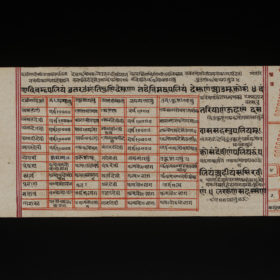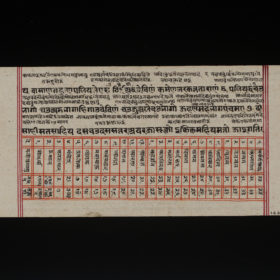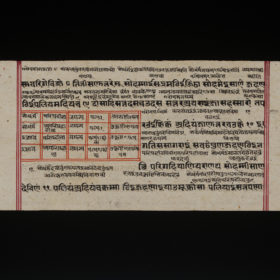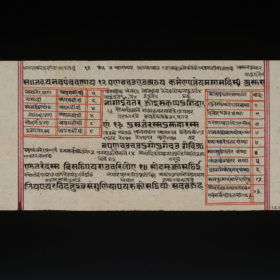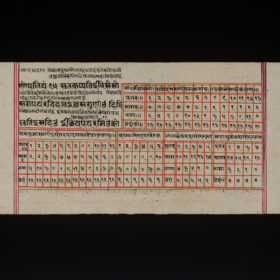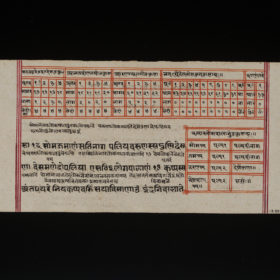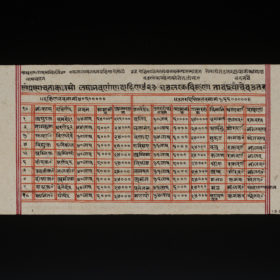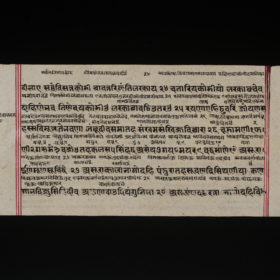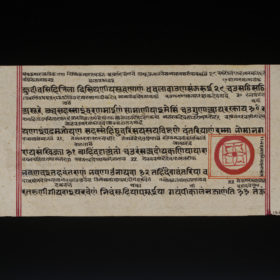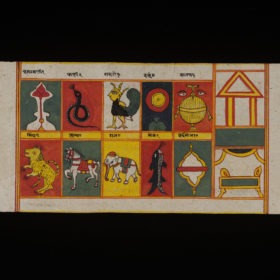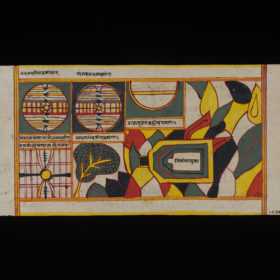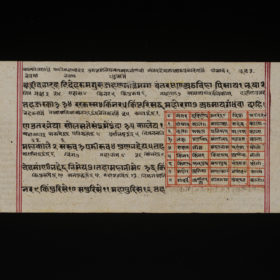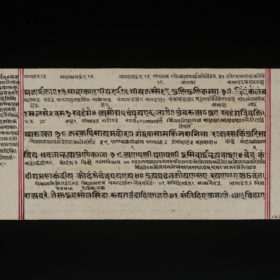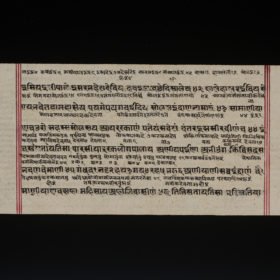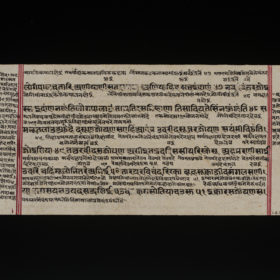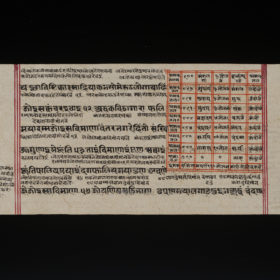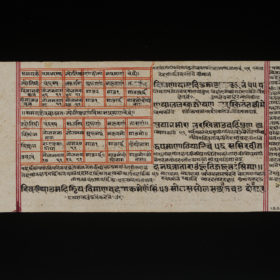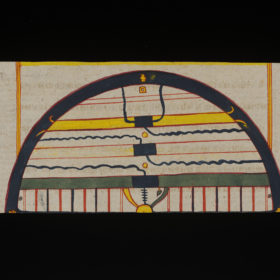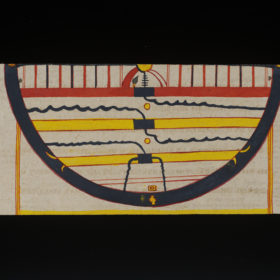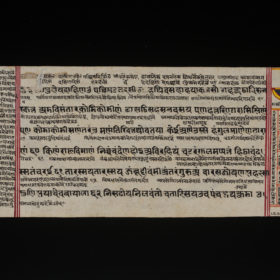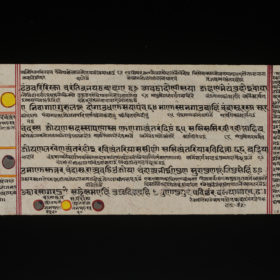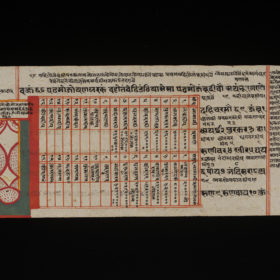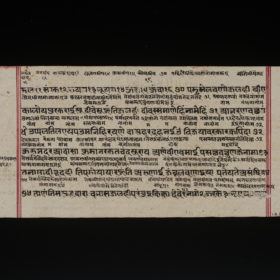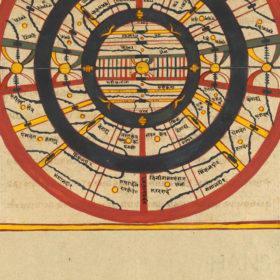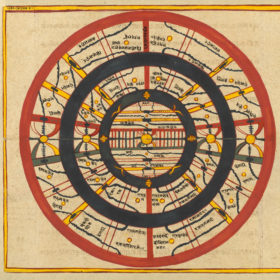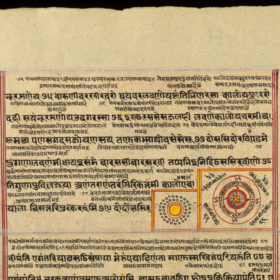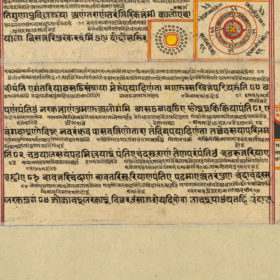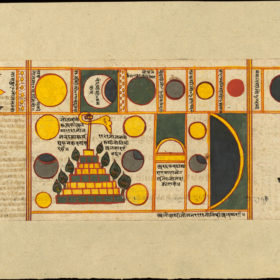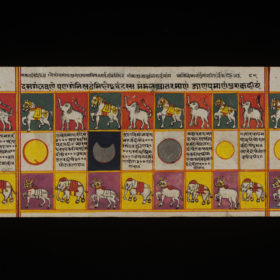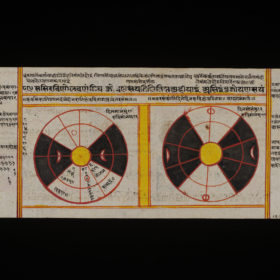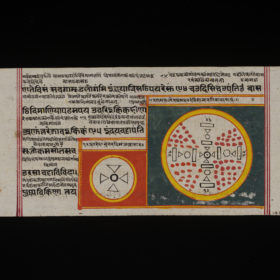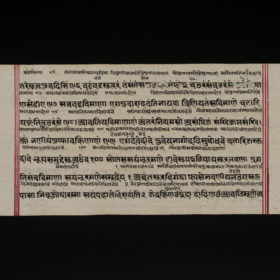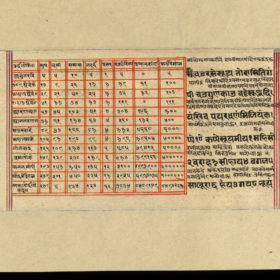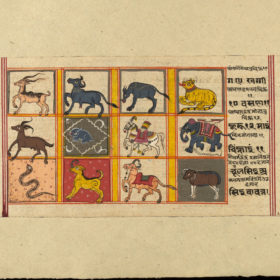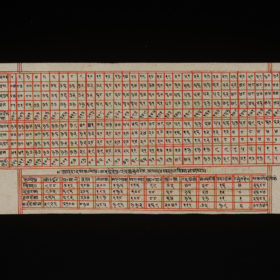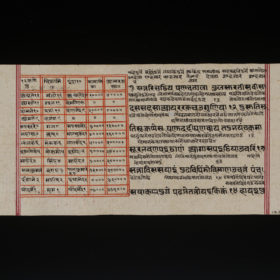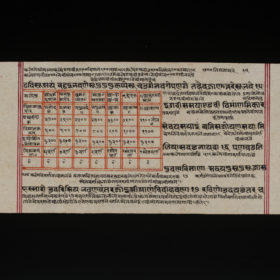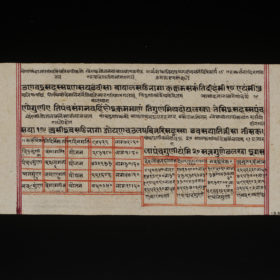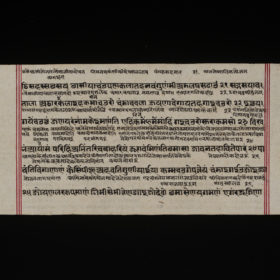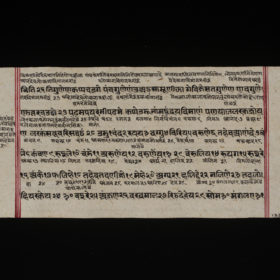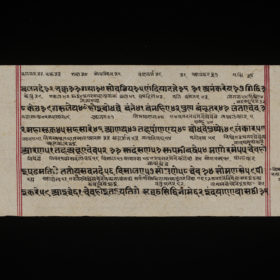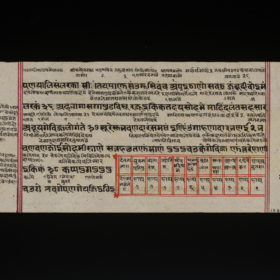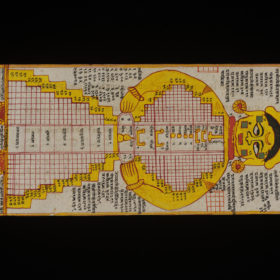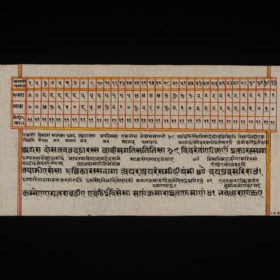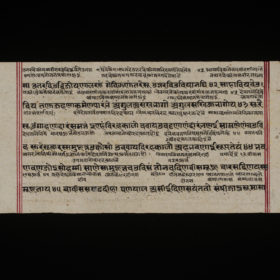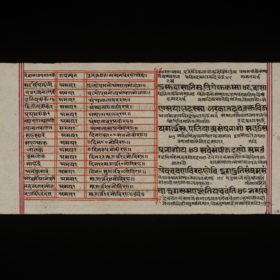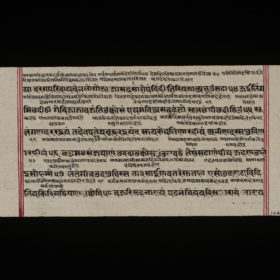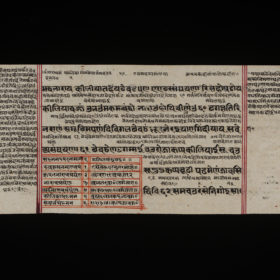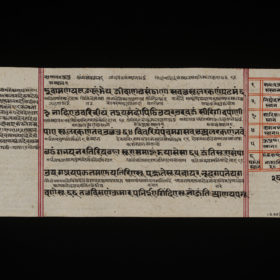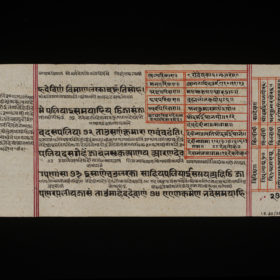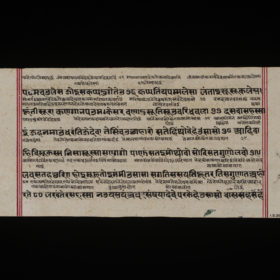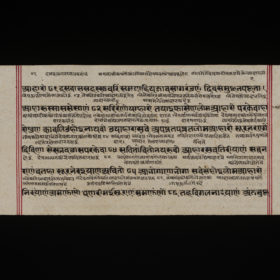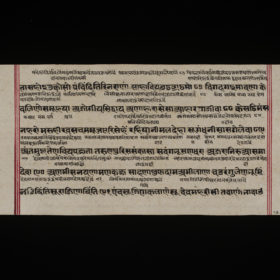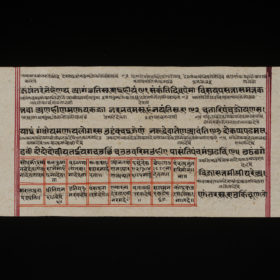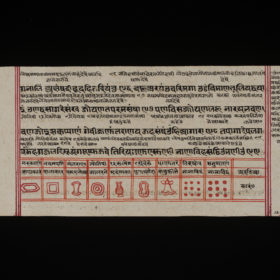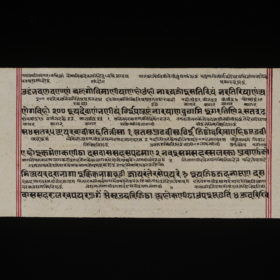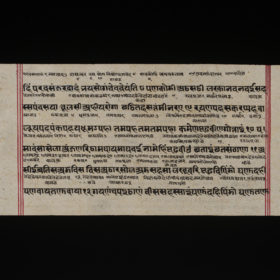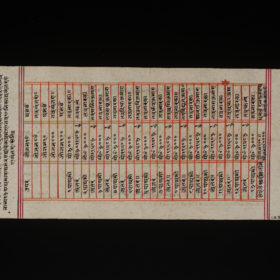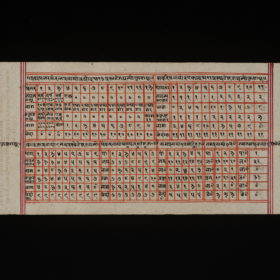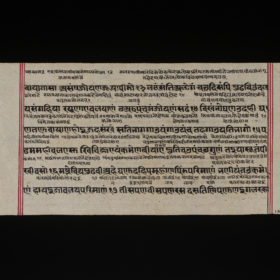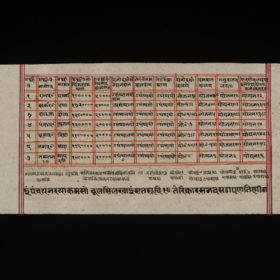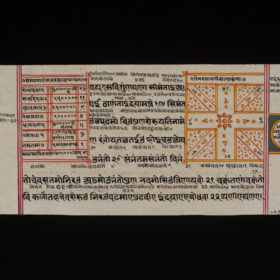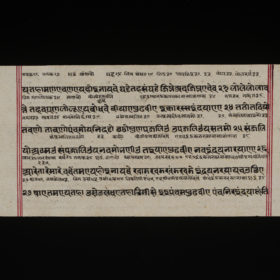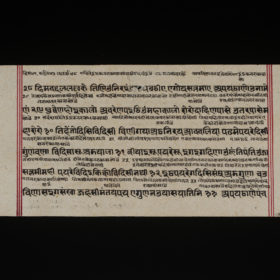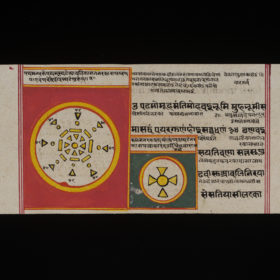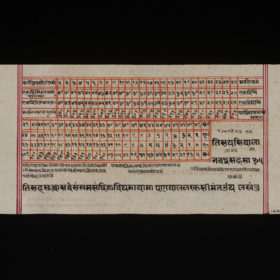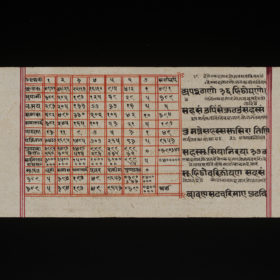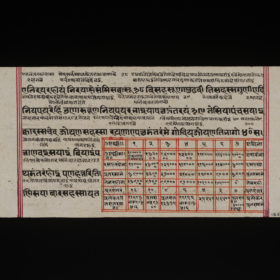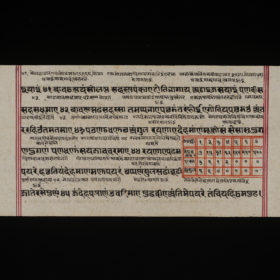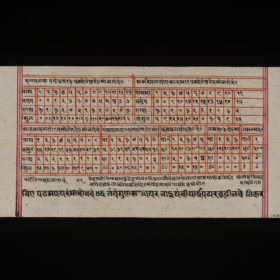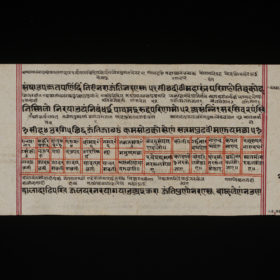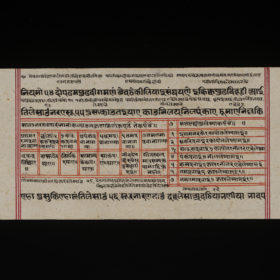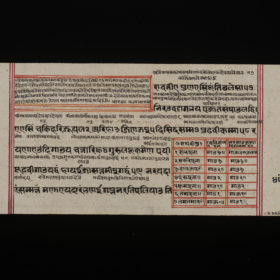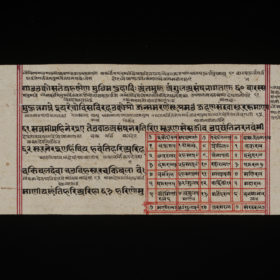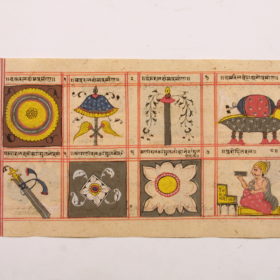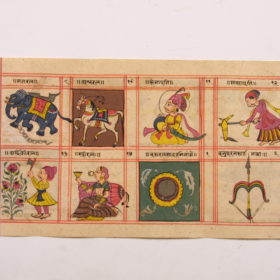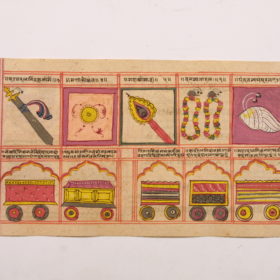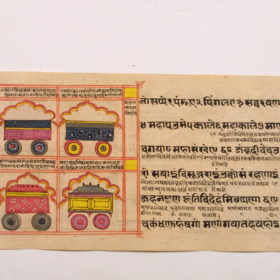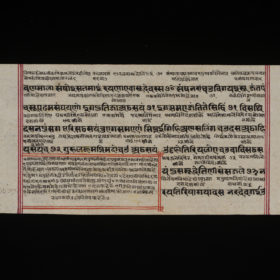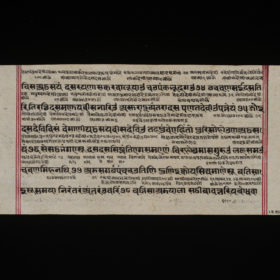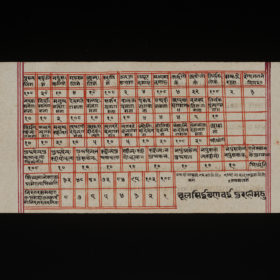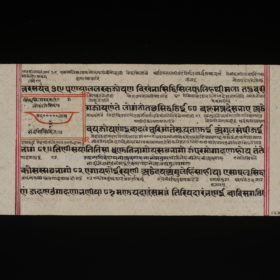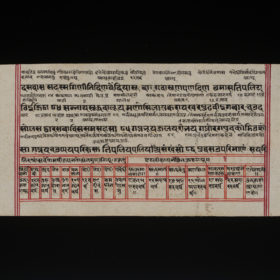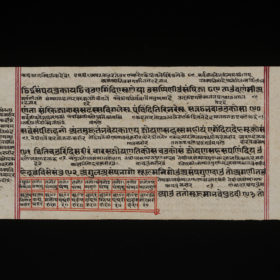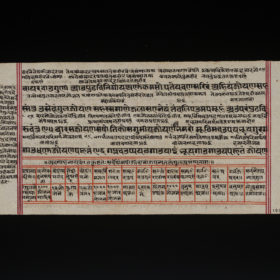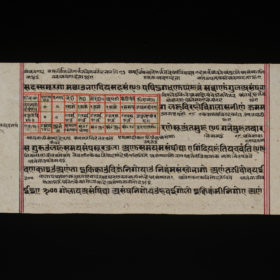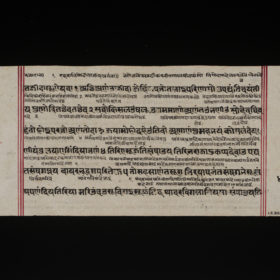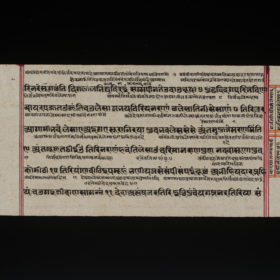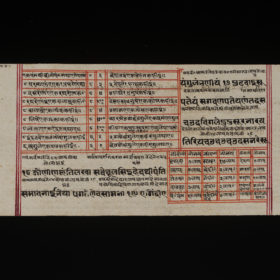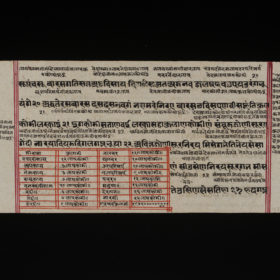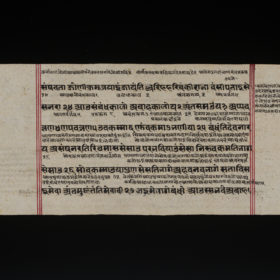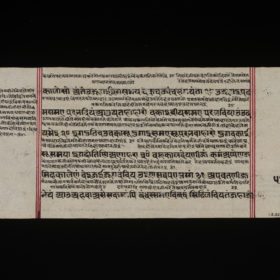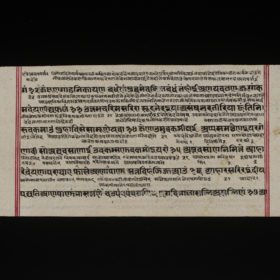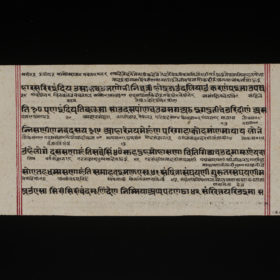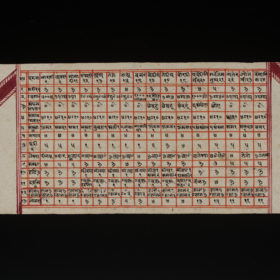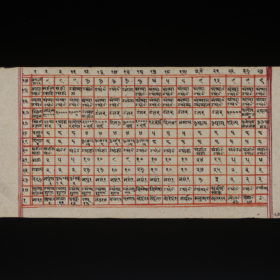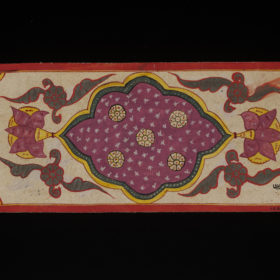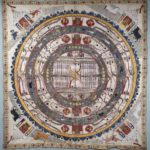
Background
Mount Meru is the centre of the universe in Jain cosmology, at the heart of the central continent called Jambū-dvīpa. Jambū is where human beings live and is in the Middle World, one of the three worlds of traditional Jain cosmology.
The Middle World is the smallest of the three worlds that make up world space – loka-ākāśa. In world space all the souls live in the different body-forms they take according to their rebirths, in the various worlds. Outside world space is the non world space – aloka-ākāśa – which is endless. However, the Middle World is the most important area from the spiritual point of view because it is the only part where human beings can live.
Pictures in cosmological works are not intended to be merely attractive. Spelling out in visual form the complex explanations found in the writings, cosmological paintings form a long-established tradition of artwork in Jain heritage.
Jains cannot advance spiritually without understanding and meditating upon cosmological theories so understanding them is crucial. Certain key religious concepts run through these theories. These include the notion of a physical soul shedding karma by moving through the cycle of rebirth to eventual omniscience and final liberation, along with the cyclical nature of time, the interconnectedness of the universe, and the importance of symmetry, repetition and balance.
Glossary
Description
This page is a diagram of planetary bodies, their distance from the ground and the distances between some of them.
All the captions on this picture are in Nāgarī script, used here to write the Gujarati language. They are Gujarati translations of the Prakrit verses 48 to 52 of the text of the manuscript. However, since the diagram takes up the whole page, there is no space for the text itself.
There are two levels to this painting, each divided into several panels.
Top row
This is a graphic representation of verses 48 to 50 in the original Prakrit text. These eight panels deal with the distance of the various luminaries or planetary bodies from the surface of the earth and the distance between them. Each panel has a yellow border and a caption.
From left to right:
- Mount Meru and its forests with the luminaries above
- the sun
- the moon
- one constellation standing for all the constellations
- Mercury
- Venus
- Jupiter
- Mars
- Saturn.
The planets have the colour with which they are traditionally associated – red for Mars, black for Saturn.
Note that the folios are loose so can be turned in various directions. Here, if the folio is rotated the viewer can read the captions on the top panel more easily, reading upwards from Mount Meru on the bottom.
Captions
All in Nāgarī script and going from left to right, the captions are presented in the table.
|
Prakrit caption |
English rendering |
|---|---|
|
tārā 790 jojana uṃcā samabhūtala thakī |
The stars are 790 yojanas higher than the foot of Mount Meru |
|
tārā thakī jojana 10 sūrya ūṃco |
The sun is 10 yojanas higher than the stars |
|
sūrya thī jo° 80 caṃdra uṃco |
The moon is 80 yojanas higher than the sun |
|
caṃdra thī yo° 4 nakṣatra |
The constellations are 4 yojanas from the moon |
|
naṣatra thī jo°4 Budha ūṃco |
Mercury is 4 yojanas higher than the constellations |
|
Budha thī jo° 3 Śukra uṃca jāṃ° |
Venus is known to be 3 yojanas higher than Mercury |
|
Śukra thī jo 3 Bṛhaspa° |
Jupiter is 3 yojanas from Venus |
|
Bṛhaspatī thī yo 3 Maṃga ja° |
Mars is 3 yojanas from Jupiter |
|
Śanī Maṃgala thī jo 3 anī |
Saturn is known to be 3 yojanas from Mars |
Bottom row
There are three panels on this row, each containing a different picture and caption.
Left-hand panel
The tiered structure with a banner on top is Mount Meru. It is the centre of the Jain world, at the heart of the Mahā-videha and Jambū-dvīpa. It has three terraces, here painted in green. Each one is smaller than the one below and is planted with forests. On the top one – the cūlikā – is a temple to the Jinas, which is here symbolised by the banner. This is often seen at the top of Jain temples even today.
The total height of Mount Meru is 100,000 yojanas, 99,000 of which are above the ground while 1,000 is underground.
The circles around Mount Meru represent the five types of luminaries or planetary bodies. They are known as Jyotiṣa or, here, Jotisi:
- suns – sūrya
- moons – candra
- planets – graha
- constellations – nakṣatra
- stars – tārā.
The caption on the left side of the banner reads:
Jotiṣī Meru thakī alagā 1121 jojana caṃdramā sūrya graha nakṣatra tārā rahai.
The luminaries – moon, sun, planets, constellations, stars – are at a distance of 1121 yojanas from the Meru.
The caption on the right side says the same:
1121 jojana Meru thakī Jotiṣī alagā rahe chaiṃ //
The luminaries are at a distance of 1121 yojanas from the Meru.
Central panel
This consists of a green background above a semicircle shape, which sits on a yellow band above a caption.
This caption, a Gujarati rendering of part of verse 52, describes the shape of the luminaries. Although the luminary pictured here is a semicircle, the usual shape is the circle.
The caption reads:
araddha kavaṭṭhāgārā e gāhā no artha teha no jantra jāṃṇavo
These planets have the shape of half-circles. The meaning should be known from the diagram.
Right panel
There are two smaller sections making up the panel. In the left-hand one, yellow circles stack vertically around a grey circle, which has a darker slice.
The section on the right has a green background with a large black semicircle down the left.
This diagram can be understood with the caption below:
aloka thī jojana 1111 Jotiṣī alagā rahai //
The luminaries are at a distance of 1111 yojanas from the trans‑cosmic space
The trans-cosmic space is a vacuum. The black semicircle on the right probably represents this vaccum. This diagram is an attempt to depict part of verse 51 of the Saṃgrahaṇī-ratna or Trailokyadīpikā.
Other visual elements
The right-hand margin contains the number 14, which is the folio number.
- Source:
Victoria and Albert Museum
- Shelfmark:
IS. 35-1971
- Author:
Śrīcandra
- Date of creation:
18th century
- Folio number:
14 verso
- Total number of folios:
56
- Place of creation:
Rajasthan; copied in Srāparanagara
- Language:
Jaina Māhārāṣṭrī Prākrit and Gujarati
- Medium:
watercolour on paper
- Size:
25 x 11.5 cms
- Copyright:
V&A Images/Victoria and Albert Museum, London
- Image Copyright:
- +
- aAbhavya
- aAbhinandana
- aAbhiṣeka
- aĀcāra
- aĀcārāṅga-sūtra
- aĀcārya
- aAchalbhrata
- aAḍhāī-dvīpa
- aAdharma
- aAdho-loka
- aAdhyayana
- aAdvaita Vedānta
- aĀgama
- aAghātīya
- aAghātīya-karman
- aAgnibhuti
- aAgra
- aĀhāra
- aAhiṃsā
- aAhimsa Day
- aAjita
- aAjīva
- aAkampit
- aĀkāśa
- aAkbar the Great
- aAkṣaya-tṛtīyā
- aAlauddin Khalji
- aAlbert Einstein
- aAllah
- aAlms
- aĀlocanā
- aAloka-ākāśa
- aAmāri
- aAmbikā or Kūṣmāṇḍinī
- aAnagāra
- aAnanta
- aAnarthadaṇḍa
- aAnaśana
- aAnekānta-vāda
- aAṅga
- aAniconism
- aAnojjā
- aAntarāla
- aAntarāya-karma
- aAṇu
- aAṇu-vrata
- aAnukampā
- aAnuprekṣā
- aAnusvāra
- aApabhraṃśa
- aAparigraha
- aAra
- aĀrambha
- aĀrambhaja
- aĀratī
- aArdhamāgadhī Prākrit
- aArhaṃ
- aArhat
- aArśana-āvaraṇīya-karma
- aĀrta-dhyāna
- aĀryikā
- aĀryikā Jñānamati
- aĀśātanā
- aĀścarya
- aAscetic
- aAsceticism
- aAshram
- aAspiration
- aĀsrava
- aAṣṭa-maṅgala
- aAṣṭāpada
- aAstikāya
- aAstrolabe
- aAsura
- aAtheism
- aAticāra
- aAtiśayakṣetra
- aAtithisaṃvibhāgavrata
- aĀtma-vāda
- aĀtman
- aAuṃ
- aAurangzeb
- aAuspicious
- aAusterity
- aAvadhāna
- aAvadhi-jñāna
- aĀvaraṇī-yakarman
- aAvasarpiṇī
- aAvatāra
- aAvidyā
- aAxiom
- aĀyāga-paṭa
- aĀyambil
- aĀyu-karma
- aĀyurveda
- bBabur
- bBāhubali
- bBaladeva
- bBālāvabodha
- bBandha
- bBasadi
- bBazaar
- bBhadrankarvijay
- bBhagavant
- bBhaktāmara-stotra
- bBhakti
- bBhale
- bBharata
- bBhāṣā
- bBhāṣya
- bBhaṭṭāraka
- bBhāva
- bBhāva-pūjā
- bBhāvanā
- bBhavana-vāsin
- bBhavya
- bBhavyatva
- bBhaya
- bBhoga-bhūmi
- bBhogopabhoga
- bBodhi
- bBollywood
- bBrahmā
- bBrahma-deva
- bBrahmacārī
- bBrāhmaṇa
- bBraj Bhāṣā
- bBright fortnight
- bBritish Raj
- bBuddha
- bBuddhi-sagar
- bBuddhism
- bBuddhist
- cCaitya
- cCaityavāsin
- cCakravartin
- cCakreśvarī
- cCāmara
- cCandanā
- cCandragupta
- cCandraprabha
- cCanon
- cCāritra
- cCāritramohanīya-karman
- cCarũrī
- cCaste
- cCaturvidha-saṅgha
- cCaturviṃśati-stava
- cCāturyāma
- cCE
- cCelibacy
- cCha
- cChadmastha
- cChastity
- cCheda-sūtra
- cChristian
- cChristianity
- cClergy
- cCloning
- cColophon
- cCommentary
- cConch
- cConfession
- cCongregation
- cConsecration
- cCosmology
- cCremation
- cCrore
- cCult
- cCūrṇi
- dDādā-guru
- dDalit
- dDāna
- dDaṇḍa
- dDark fortnight
- dDarśana
- dDarśanamohanī-yakarman
- dDaśa-lakṣaṇa-parvan
- dDeity
- dDelhi Sultanate
- dDerāsar
- dDeśāvakāśika-vrata
- dDetachment
- dDevanāgarī
- dDevānandā
- dDevarddhi-gani
- dDevotee
- dDhamal
- dDhanuṣ
- dDhāra
- dDharma
- dDharma-dhyāna
- dDharma-sāgara
- dDharmastikaya
- dDhātakīkhaṇḍa
- dDholak
- dDhyāna
- dDiaspora
- dDig-vrata
- dDigambara
- dDīkṣā
- dDisciple
- dDīvālī
- dDivya-dhvani
- dDNA
- dDoctrine
- dDogma
- dDonor
- dDoṣa
- dDravya
- dDravya-pūjā
- dDrone
- dDuṣamā
- dDuṣamā-duṣamā
- dDuṣamā-suṣamā
- dDveṣa
- dDvīpa
- eEast India Company
- eEightfold Path
- eEkānta-vāda
- eEkendriya
- eElder
- eElders
- eEschatology
- eEtc up to
- fFarmān
- fFast
- fFatehpur Sikri
- fFestival
- fFestschrift
- fFiruz Shah
- fFly-Whisks
- fFolio
- fFour Noble Truths
- gGaccha
- gGaṇa
- gGaṇadhara
- gGanadharavada
- gGaṇeśa
- gGaṇin
- gGarba
- gGarbha
- gGarbha-gṛha
- gGaruḍa
- gGati
- gGene
- gGenomics
- gGhātī-yakarman
- gGhātīya
- gGhaznavid
- gGhiyasuddin Tughlaq
- gGhurid
- gGloss
- gGotra-karma
- gGujarāt
- gGujarati
- gGuṇa
- gGuṇa-sthāna
- gGuṇa-vrata
- gGupti
- gGuru
- gGuruṇī
- hHagiography
- hHajj
- hHaṃsa
- hHaribhadra
- hHariṇaigameṣin
- hHasta
- hHeresy
- hHiṃsā
- hHindi
- hHindu
- hHinduism
- hHīravijaya
- hHoroscope
- hHrīṃ
- hHumayun
- hHymn
- iIconoclasm
- iIconography
- iIdol
- iIndian Independence
- iIndology
- iIndra
- iIndrabhūti Gautama
- iIndriya
- iInitiation
- iIntercession
- iInvocation
- iIQ
- iIslam
- iIslamicate
- iIṣṭadevatā
- iĪśvara
- jJagat
- jJahangir
- jJain
- jJaina Devanāgarī
- jJaina Śaurasenī
- jJaina-dharma
- jJainaśāsana
- jJainness
- jJaisalmer
- jJamāli
- jJambū-dvīpa
- jJames Burgess
- jJanma
- jJanma-kalyāṇa
- jJarā
- jJāti
- jJina
- jJina-āgama
- jJina-bhavana
- jJina-bimba
- jJina-mātā
- jJinacandra-sūri
- jJinadatta
- jJinaprabha
- jJīva
- jJñāna
- jJñāna-āvaraṇīya-karma
- jJñāna-āvarṇiya
- jJñānsundar
- jJyotiṣka
- kKāla
- kKālakācārya-kathā
- kKālidāsa
- kKalpa-sūtra
- kKalpa-vṛkṣa
- kKalyāṇaka
- kKalyanvijay
- kKamaṇḍalu
- kKamaṭha
- kKarma
- kKarma-bhūmi
- kKarma-grantha
- kKarma-prakṛti
- kKarma-vāda
- kKarmon
- kKarnataka
- kKaṣāya
- kKathā
- kKāvya
- kKāya
- kKāyotsarga
- kKeśa-loca
- kKetu
- kKevala-jñāna
- kKevalin
- kKhalji
- kKharatara-gaccha
- kKnowledge
- kKriyā
- kKriyā-vāda
- kKṛṣṇa
- kKṣamā-śramaṇa
- kKṣapakaśreṇi
- kKṣatriya
- kKṣullaka
- kKulakara
- kKundakunda
- kKunthu
- lLabdhi
- lLaity
- lLakh
- lLāñchana
- lLands of Action
- lLaukāntika
- lLavaṇa-samudra
- lLeśyā
- lLiṅga
- lLinguistics
- lLoka
- lLoka-ākāśa
- lLoka-puruṣa
- lLoka-vāda
- lLotus
- lLotus lake
- mMadhya-loka
- mMahā-videha
- mMahā-vrata
- mMahābhārata
- mMahāmastakābhiṣeka
- mMāhārāṣṭra
- mMāhārāṣṭrī Prākrit
- mMahattarā Yākinī
- mMahāvīr Jayantī
- mMahāvīra
- mMakāra
- mMakkhali Gośāla
- mMalli
- mMāna-stambha
- mManaḥ-paryāya-jñāna
- mMaṇḍala
- mMaṇḍapa
- mMandit
- mMaṅgala
- mMantra
- mMantras
- mManuṣya-loka
- mMarāṭhī
- mMārgaṇā
- mMartyr
- mMarudevī
- mMaṭha
- mMati-jñāna
- mMauryaputra
- mMecca
- mMendicant lineage
- mMetarya
- mMiracle
- mMithyādṛṣṭi
- mMohandas Gandhi
- mMohanīya-karma
- mMokṣa
- mMonastic order
- mMonasticism
- mMonk
- mMonotheism
- mMosque
- mMount Meru
- mMount Sammeta
- mMṛgāvatī
- mMughal
- mMuhammad
- mMuhammad bin Tughlaq
- mMuhpattī
- mMūla-sūtra
- mMūlaguṇa
- mMumbaī
- mMuni
- mMunisuvrata
- mMurad Bakhsh
- mMūrti-pūjaka
- mMuslim
- mMysticism
- nNābhi
- nNāga-kal
- nNāgapurīya Tapā-gaccha
- nNāgarī
- nNāma-karma
- nNamaskāra-mantra
- nNami
- nNandīśvara-dvīpa
- nNandivardhana
- nNandyāvarta
- nNāraka
- nNāraki
- nNasalisation
- nNātha
- nNavrātrī
- nNaya-vāda
- nNemi
- nNidāna
- nniggaṃthāṇa vā 2
- nniggaṃtho vā 2
- nNigoda
- nNihnava
- nNikṣepa
- nNirgrantha
- nNirjarā
- nNirvāṇa
- nNiryukti
- nNiṣidhi
- nNitya
- nNiyati
- nNo-kaṣāya
- nNudity
- nNun
- oOcean of milk
- oOmniscience
- oOrdination
- ppa°
- pPadmaprabha
- pPadmāsana
- pPadmāvatī
- pPādukā
- pPalanquin
- pPalette
- pPañca-muṣṭi
- pPāṇḍava
- pPaṇḍit
- pPandit Dalsukh D. Malvania
- pPandit Sukhlalji
- pPāṇipātra
- pPāpa
- pParamātman
- pParameṣṭhin
- pPāraṇā
- pParigraha
- pPariṇāma
- pParīṣaha
- pParokṣa
- pPārśva
- pPārśvanātha
- pParyāya
- pParyuṣaṇ
- pPaṭa
- pPatan
- pPātra
- pPenance
- pPersian
- pPhala
- pPhilology
- pPicchikā
- pPilgrimage
- pPīr
- pPolymath
- pPoṣadha
- pPossession
- pPothī
- pPrabhas
- pPradakṣiṇā
- pPradeśa
- pPrākāra
- pPrakīrṇaka-sūtra
- pPrākrit
- pPramāda
- pPramukhā
- pPrati-vāsudeva
- pPratikramaṇa
- pPratimā
- pPratiṣṭhā
- pPratyākhyāna
- pPratyakṣa
- pPravacana
- pPrāyaścitta
- pPrayer
- pPre-modern
- pPreach
- pPredestination
- pProtestant
- pProvenance
- pPudgala
- pPūjā
- pPujārī
- pPukharavara-dvīpa
- pPuṇya
- pPūrva
- pPuṣkara-dvīpa
- pPuṣpadanta
- pPyre
- qQur’an
- rRāga
- rRāhu
- rRainy season
- rRajasthan
- rRajasthani
- rRājimatī
- rRajoharaṇa
- rRajput
- rRāma
- rRāmāyaṇa
- rRangoli
- rRās-garbā
- rRasa
- rRathanemi
- rRatna-traya
- rRātri-bhojana
- rRaudra-dhyāna
- rRecto
- rRelic
- rRenunciation
- rRetroflex
- rRevatī
- %Ṛg-veda
- rRite
- rRosary
- %Ṛṣabha
- %Ṛṣabhanātha
- rRupee
- sSaciyā Mātā
- sSādhu
- sSādhvī
- sSāgāra
- sSaint
- sŚaivaism
- sŚaka-saṃvat
- sSallekhanā
- sŚalya
- sSamacatuṣṭha
- sSamādhimaraṇa
- sSamaṇi
- sSāmarambha
- sSamavasaraṇa
- sSāmāyika
- sSaṃbhava
- sSamiti
- sSaṃjñā
- sSaṃkalpaja
- sSaṃsāra
- sSamudghāta
- sSaṃvara
- sSaṃvega
- sSamyak-cāritra
- sSamyak-darśana
- sSamyak-jñāna
- sSamyaktva
- sSaṃyama
- sSanctuary
- sSandalwood
- sSaṇgha
- sSanskrit
- sSant
- sŚānti
- sSapta-bhaṅgi-naya
- sSārambha
- sSarasvatī
- sSarvajña
- sSāsan-devi
- sŚāsana-devatā
- sŚāstra
- %Ṣaṭ-jīvanikāya
- sSatī
- sSatīmātā
- sSatya
- sSchism
- sScribe
- sScripture
- sSect
- sSecularism
- sŚenāī
- sSermon
- sŚeṣavatī
- sSevā
- sSeven fields of donation
- sShah Jahan
- sShantidas Jhaveri
- sShrine
- sSiddha
- sSiddha-śilā
- sSiddhacakra or Navadevatā
- sSiddhānta
- sSiddhārtha
- sSiddhi
- sSikh
- sSikhism
- sŚikṣā-vrata
- sŚīla
- sSin
- sSindh
- sŚītala
- sŚiva
- sSkandha
- sSomanatha
- sŚraddhā
- sŚramaṇa
- sŚrāvaka
- sŚrāvakācāra
- sŚrāvikā
- sŚreyāṃsa
- sŚrī
- sŚrīvatsa
- sŚruta-jñāna
- sŚruta-pañcamī
- sSthānaka-vāsin
- sSthāpanācārya
- sSthāvara
- sSthavira
- sSthiti
- sStrīmukti
- sStūpa
- sSubcontinent
- sSudarshana
- sŚuddhi
- sSudharma
- sŚūdra
- sSufism
- sSukha
- sŚukla-dhyāna
- sSulasā
- sSultan
- sSumati
- sSundarśrī
- sSupārśva
- sSūri
- sSuṣamā
- sSuṣamā-duṣamā
- sSuṣamā-suṣamā
- sSūtra
- sSuyam me ausam! Tenam bhagavaya evamakkhayam
- sSvādhyāya
- sSvāhā
- sSvastika
- sŚvetāmbara
- sŚvetāmbara Terāpanthin
- sŚvetāmbaras
- sSwan
- sSyād-vāda
- tTabla
- tTantra
- tTapā-gaccha
- tTapas
- tTāraṇ Svāmī Panth
- tTattva
- tTattvārtha-sūtra
- tTemple
- tTemple-city
- tThe Enlightenment
- tTheology
- tThree worlds
- %Ṭīkā
- tTilaka
- tTīrtha
- tTīrthaṃkaranāma-karman
- tTīrthankara
- tTransliteration
- tTrasa
- tTrasa-nāḍī
- tTriśalā
- tTriṣaṣṭi-śalākā-puruṣa-caritra
- tTti bemi
- tTughlaq
- tTunk
- uUdumbara
- uUniversal History
- uUpādhyāya
- uUpāṅga
- uUpaniṣads
- uUpāsaka
- uUpasarga
- uUpāśraya
- uŪrdhva-loka
- uUtsarpiṇī
- uUttarādhyayana-sūtra
- vVāhana
- vVaimānika
- vVairāgya
- vVaiṣṇava
- vVaiśramaṇa
- vVaiśya
- vValabhī
- vVanaspatikāya
- vVandana
- vVaṇik
- vVarṇa
- vVāsudeva
- vVāsupūjya
- vVayubhūti
- vVeda
- vVedanīya-karma
- vVegetarianism
- vVehicle
- vVernacular
- vVerso
- vVidyā
- vVidyā-devī
- vVihāra
- vVijñapti-patra
- vVikrama-saṃvat
- vVikṛti
- vVimala
- vVinaya
- vVipāka
- vVirji Vora
- vVirodhaja
- vVīrya
- vVisarga
- vViṣṇu
- vVītarāga
- vVizier
- vVotive
- vVow
- vVrata
- vVS
- vVyakta
- vVyantara
- vVyasana
- yYakṣa
- yYakṣī
- yYantra
- yYaśoda
- yYaśovijaya
- yYati
- yYātrā
- yYoga
- yYoginī
- yYojana
Description
This page is a diagram of planetary bodies, their distance from the ground and the distances between some of them.
All the captions on this picture are in Nāgarī script, used here to write the Gujarati language. They are Gujarati translations of the Prakrit verses 48 to 52 of the text of the manuscript. However, since the diagram takes up the whole page, there is no space for the text itself.
There are two levels to this painting, each divided into several panels.
Top row
This is a graphic representation of verses 48 to 50 in the original Prakrit text. These eight panels deal with the distance of the various luminaries or planetary bodies from the surface of the earth and the distance between them. Each panel has a yellow border and a caption.
From left to right:
- Mount Meru and its forests with the luminaries above
- the sun
- the moon
- one constellation standing for all the constellations
- Mercury
- Venus
- Jupiter
- Mars
- Saturn.
The planets have the colour with which they are traditionally associated – red for Mars, black for Saturn.
Note that the folios are loose so can be turned in various directions. Here, if the folio is rotated the viewer can read the captions on the top panel more easily, reading upwards from Mount Meru on the bottom.
Captions
All in Nāgarī script and going from left to right, the captions are presented in the table.
|
Prakrit caption |
English rendering |
|---|---|
|
tārā 790 jojana uṃcā samabhūtala thakī |
The stars are 790 yojanas higher than the foot of Mount Meru |
|
tārā thakī jojana 10 sūrya ūṃco |
The sun is 10 yojanas higher than the stars |
|
sūrya thī jo° 80 caṃdra uṃco |
The moon is 80 yojanas higher than the sun |
|
caṃdra thī yo° 4 nakṣatra |
The constellations are 4 yojanas from the moon |
|
naṣatra thī jo°4 Budha ūṃco |
Mercury is 4 yojanas higher than the constellations |
|
Budha thī jo° 3 Śukra uṃca jāṃ° |
Venus is known to be 3 yojanas higher than Mercury |
|
Śukra thī jo 3 Bṛhaspa° |
Jupiter is 3 yojanas from Venus |
|
Bṛhaspatī thī yo 3 Maṃga ja° |
Mars is 3 yojanas from Jupiter |
|
Śanī Maṃgala thī jo 3 anī |
Saturn is known to be 3 yojanas from Mars |
Bottom row
There are three panels on this row, each containing a different picture and caption.
Left-hand panel
The tiered structure with a banner on top is Mount Meru. It is the centre of the Jain world, at the heart of the Mahā-videha and Jambū-dvīpa. It has three terraces, here painted in green. Each one is smaller than the one below and is planted with forests. On the top one – the cūlikā – is a temple to the Jinas, which is here symbolised by the banner. This is often seen at the top of Jain temples even today.
The total height of Mount Meru is 100,000 yojanas, 99,000 of which are above the ground while 1,000 is underground.
The circles around Mount Meru represent the five types of luminaries or planetary bodies. They are known as Jyotiṣa or, here, Jotisi:
- suns – sūrya
- moons – candra
- planets – graha
- constellations – nakṣatra
- stars – tārā.
The caption on the left side of the banner reads:
Jotiṣī Meru thakī alagā 1121 jojana caṃdramā sūrya graha nakṣatra tārā rahai.
The luminaries – moon, sun, planets, constellations, stars – are at a distance of 1121 yojanas from the Meru.
The caption on the right side says the same:
1121 jojana Meru thakī Jotiṣī alagā rahe chaiṃ //
The luminaries are at a distance of 1121 yojanas from the Meru.
Central panel
This consists of a green background above a semicircle shape, which sits on a yellow band above a caption.
This caption, a Gujarati rendering of part of verse 52, describes the shape of the luminaries. Although the luminary pictured here is a semicircle, the usual shape is the circle.
The caption reads:
araddha kavaṭṭhāgārā e gāhā no artha teha no jantra jāṃṇavo
These planets have the shape of half-circles. The meaning should be known from the diagram.
Right panel
There are two smaller sections making up the panel. In the left-hand one, yellow circles stack vertically around a grey circle, which has a darker slice.
The section on the right has a green background with a large black semicircle down the left.
This diagram can be understood with the caption below:
aloka thī jojana 1111 Jotiṣī alagā rahai //
The luminaries are at a distance of 1111 yojanas from the trans‑cosmic space
The trans-cosmic space is a vacuum. The black semicircle on the right probably represents this vaccum. This diagram is an attempt to depict part of verse 51 of the Saṃgrahaṇī-ratna or Trailokyadīpikā.
Other visual elements
The right-hand margin contains the number 14, which is the folio number.






























































































